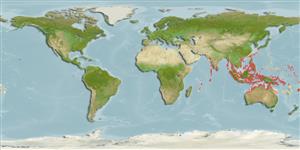Common names from other countries
Environment: milieu / climate zone / profondeur / distribution range
Écologie
marin récifal; non migrateur; profondeur 2 - 15 m (Ref. 48637). Tropical; 22°C - 28°C (Ref. 130640); 30°N - 27°S, 55°E - 174°W
Indo-West Pacific: Sri Lanka eastward thorough Indonesia to New Caledonia, north to southern Japan.
Taille / Poids / Âge
Maturité: Lm ? range ? - ? cm
Max length : 14.0 cm SL mâle / non sexé; (Ref. 108462)
Description synthétique
Clés d'identification | Morphologie | Morphométrie
Rayons mous dorsaux (Total) : 27 - 30; Épines anales: 0; Rayons mous anaux: 26 - 29.
Body shape (shape guide): short and / or deep.
Adults inhabit reef, weed, and rubble areas on shallow coral reefs (Ref. 43248, 48637), commonly found in seagrasses (Ref. 58881). Solitary (Ref. 90102). Major food items include amphipods, polychaetes and molluscs (Ref. 58881). Oviparous (Ref. 205).
Life cycle and mating behavior
Maturité | Reproduction | Frai | Œufs | Fécondité | Larves
Masuda, H., K. Amaoka, C. Araga, T. Uyeno and T. Yoshino, 1984. The fishes of the Japanese Archipelago. Vol. 1. Tokai University Press, Tokyo, Japan. 437 p. (text). (Ref. 559)
Statut dans la liste rouge de l'IUCN (Ref. 130435: Version 2025-1)
Menace pour l'homme
Harmless
Utilisations par l'homme
Pêcheries: intérêt commercial mineur; Aquarium: Commercial
Outils
Articles particuliers
Télécharger en XML
Sources Internet
Estimates based on models
Preferred temperature (Réf.
123201): 25.4 - 29.1, mean 28.6 °C (based on 2014 cells).
Phylogenetic diversity index (Réf.
82804): PD
50 = 0.6250 [Uniqueness, from 0.5 = low to 2.0 = high].
Bayesian length-weight: a=0.02630 (0.01587 - 0.04360), b=2.96 (2.82 - 3.10), in cm total length, based on LWR estimates for this species & (Sub)family-body (Ref.
93245).
Niveau trophique (Réf.
69278): 3.0 ±0.39 se; based on food items.
Generation time: 1.3 ( na - na) years. Estimated as median ln(3)/K based on 1
growth studies.
Résilience (Réf.
120179): Haut, temps minimum de doublement de population inférieur à 15 mois (K=0.86;).
Fishing Vulnerability (Ref.
59153): Low vulnerability (16 of 100).
🛈
Nutrients (Ref.
124155): Calcium = 82 [36, 214] mg/100g; Iron = 0.862 [0.379, 2.020] mg/100g; Protein = 18.1 [15.8, 20.3] %; Omega3 = 0.105 [0.049, 0.216] g/100g; Selenium = 26.5 [12.6, 60.6] μg/100g; VitaminA = 64.5 [18.3, 237.1] μg/100g; Zinc = 1.6 [1.0, 2.6] mg/100g (wet weight);
